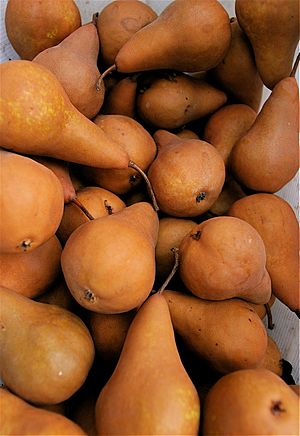Bosc pear facts for kids
Quick facts for kids Pear 'Bosc' |
|
|---|---|

Oregon-grown Bosc pears
|
|
| Genus | Pyrus |
| Species | Pyrus communis |
| Cultivar | 'Bosc' |
The Bosc pear is a special type of pear. It is also known as the Beurre Bosc or Kaiser. This pear comes from Europe, either France or Belgium. You can find Bosc pears growing in many places. These include Europe, Australia, and parts of Canada and the United States.
The Bosc pear was first grown in the early 1800s. It was named after a French plant expert, Louis Bosc. The word "Beurré" means "buttery" in French. This describes the pear's soft and juicy inside.
Bosc pears have a unique look. They have a long, thin neck and a brown, rough skin. This skin is called "russet." Their warm, cinnamon color and interesting shape make them popular in art. Many artists use Bosc pears in drawings, paintings, and photos. The white fruit inside is firm and smooth. It is often called the "aristocrat of pears."
Contents
When Did Bosc Pears Start?
It is not fully clear if the Bosc pear first grew in Belgium or France. We know that these pears were first seen in the early 1800s.
When Are Bosc Pears Available?
The season for Bosc pears begins in autumn. It lasts all the way through spring.
In South Africa, Bosc pears are picked from late January to early February.
How Do Bosc Pears Taste?
Bosc pears have firm fruit and brown skin. When they are young, they are juicy, crunchy, and sweet. As they get fully ripe, the fruit becomes even sweeter and softer. The skin might also get a bit wrinkly.
In Canada, Bosc pears that are "extra fancy" or "fancy" must be at least 54 mm wide. They should also look smooth, clean, and have a good shape.
What Nutrients Do Bosc Pears Have?
Most pears are a good source of fiber. A medium-sized pear can give you about six grams of fiber. Pears also have vitamin C. They provide about 100 calories per serving. Plus, pears have no sodium, no fat, and no cholesterol.
| Nutritional value per 100 g (3.5 oz) | |
|---|---|
| Energy | 250 kJ (60 kcal) |
|
16 g
|
|
|
1 g
|
|
|
Protein
|
1 g
|
| Vitamins | Quantity
%DV†
|
| Vitamin C |
7%
6 mg |
| Minerals | Quantity
%DV†
|
| Calcium |
2%
20 mg |
| †Percentages estimated using US recommendations for adults. | |
How Can You Use Bosc Pears?
Bosc pears have firm and solid fruit. This makes them great for many kinds of cooking. You can use them in baking, broiling, and poaching. They keep their shape well during cooking. This makes them a strong and useful fruit to use in recipes.
See also
 In Spanish: Mantecosa Bosc (pera) para niños
In Spanish: Mantecosa Bosc (pera) para niños


